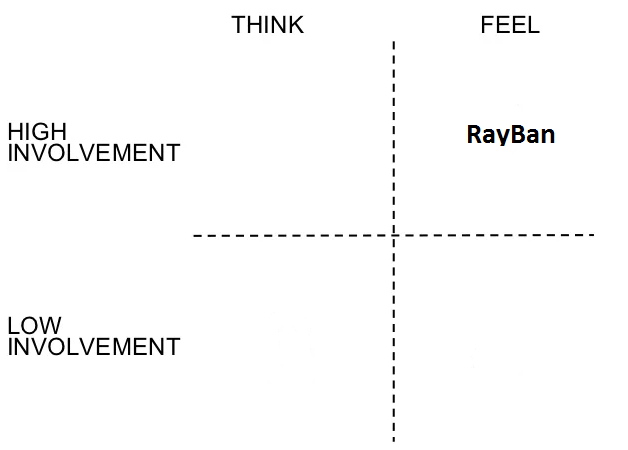Introduction
Purchasing Ray-Ban sunglasses seems to result from highly involved feelings. Although Ray-Ban is not a luxurious sunglasses brand like Chanel or Prada, it can cost substantially to necessitate reflection first, but ego and desire prompt buyers to make the final decision. From the feel vs. think perspective, the brand involves feeling. Regarding involvement level, buying Ray-Ban is a somewhat high involvement decision since it is not an every day or straightforward action for most customers. Furthermore, Ray-Ban sunglasses are strongly tied to self-image and self-importance. The brand’s sunglasses are highly differentiated products: Ray-Ban has a strong brand identity as classical cool eyewear.

Ray-Ban’s USP revolves around the fusion of style and protection. Thus, the brand is renowned for its high protection from damaging UV rays (Wang, 2020). At the same time, its sunglasses are fashionable and can be combined with a variety of outfits for occasions ranging from touristic trips to formal events (Wang, 2020). Based on the USP, rational product appeal seemingly suites Ray-Ban’s sunglasses well. The brand appears to be product-oriented since it focuses on developing and providing customers with high-quality eyewear. The way Ray-Ban markets its sunglasses revolves around the idea of premium and adhering to high standards of production.
Possible taglines:
- Eyewear that Eclipses Competition.
- Ray-Ban – I Think, Therefore Eyewear.
- Let’s the Shade Begin.
- Nothing Shades Like Ray-Ban.
- Ray-Ban – Beyond Cool.
The fourth tagline could be the most appropriate given the brand’s USP and orientation. Since one of the principal focuses in the USP is the protection from UV rays, it is significant to involve this aspect in the tagline, which the fourth one does, accentuating the brand’s superiority. Moreover, since the brand is product-oriented, so should be the tagline – this element is also covered in the slogan. The emphasized worth also contributes to the idea that Ray-Ban is a brand based on highly involved feelings.
Body Copy
Admit that you prefer Ray-Ban sunglasses because they make you look great. Their old vintage frame, gradient lenses, and the just-right fit is what you find appealing. Ray-Ban frames already become classic. Yet, an even cooler advantage is that Ray-Ban protects your eyes from injurious UV rays. All of Ray-Ban’s sunglasses look cool, and all of them provide UV protection – equal parts performance and fashion.
The Line of Action
A suitable line of action for Ray-Ban sunglasses would be to pay more attention to social media marketing. Currently, this type of advertising seems to gain more traction and eclipse other more traditional types such as email and broadcasting advertising. Interacting with customers is essential for brand awareness, and social media platforms present an optimal opportunity for this. In this way, Ray-Ban could engage with their younger target audience and increase brand awareness among them. Additionally, when the public health situation normalizes, the brand could host a charitable event, improving brand image.

Ray-Ban’s target audience seems varied – the brand appeals equally to younger and middle-aged men and women belonging to the upper-middle-class and middle-class. Therefore, the ad does not cater specifically to one demographic and strives to be comprehensive. The selected tagline considers competition that Ray-Ban may face; nonetheless, the brand appears to be leading in its segment, as more luxurious companies such as Versace and Michael Kors target entirely different population groups. The product orientation and the area’s specificity are also considered in the body copy, addressing the buyer’s self-image and need for a premium quality product.
Reference
Wang, A. (2020). How did Ray-Ban conquer the sunglasses market?. Flux Magazine. Web.